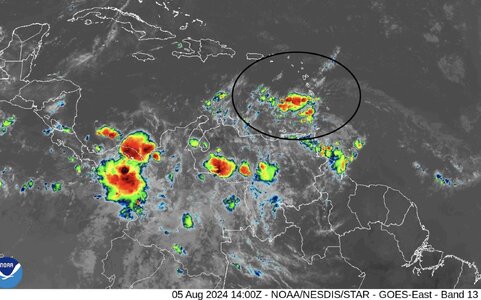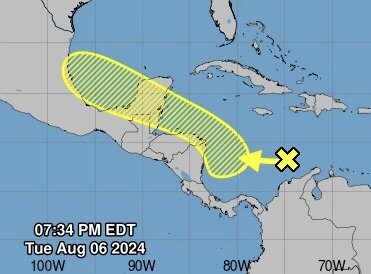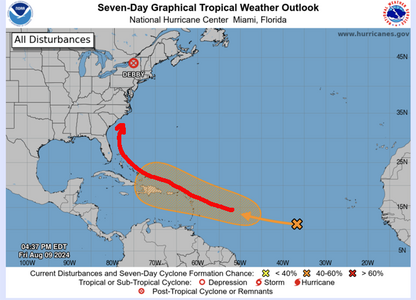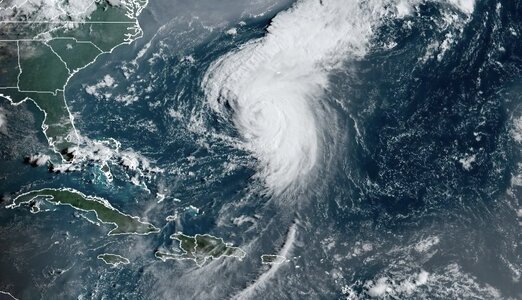Dan Robinson
EF5
Dry slot looking decent now for tornado potential if that can maintain, though I’m still not considering chasing.



Don't the 12Z ECMWF spaghetti plots veer off without striking the U.S.?ATM = no forecast as far as I'm concerned, as even a minor wiggle at this point makes a huge difference in the long term track. The GFS track (in red) wants to threaten the east coast.
Some of the best chase terrain is there the further south in the state of Delaware. And, my usual chase partner was about 100 yards or so from the New Castle County EF1 (of course, it helps that he works in Wilmington, DE).Remnants of Debby place my area (southeast PA) squarely in the 5% TOR risk today, which is pretty rare around here. I haven’t tried to chase a setup like this before so I don’t know a ton about it, but I suspect it’s more of a random, nowcasting type of situation without an ability to target a specific area or initiating boundary. Almost like trying to chase an embedded QLCS tornado, Certainly not worth working too hard at it. Local terrain, traffic, etc. make it impractical to chase out here. It’s a little better about 90 minutes or two hours west of here (Lancaster area for example) as well as east in parts of southern NJ, but doesn’t seem worth the trip, and again not really “targetable.” Also can’t really afford to break away from work until the afternoon, and it seems the chance for discrete storms is better early in the day, with a line forecast for later. So I’ll probably just keep an eye on the radar in case anything interesting pops locally.
Of what?I think initial tracks do offer some public awareness
Yes, a big problem is individuals taking a single deterministic model run day 10 and beyond, running with that, and treat it as "this is what is going to happen." No uncertainty or caveats given. And what makes it worse now, individual ensemble member tracks and plots are now available, so they will find *one* member on any global model that shows a direct hurricane hit in the CONUS, and take that and post.I think initial, long track forecasts do offer some public awareness, as long as there is a clear notation of possible track errors. AL98 has shifted east, but the original / current forecast track is a threat to Caribbean interests and it could still make a left turn into the east coast. There are also considerations for mariners traveling into the Atlantic and coastal wx issues far away from the storm even if it turns, e..g, tides, rip currents, surge, waves, etc. Cyclones are very difficult to forecast before they actually have a steady core with height and become part of the overall pattern.
The problem is when people take the long term forecast tracks and present them as "guaranteed" strike zones.

Move a few letters down the alphabet, from Beryl to Ernesto, and what a difference.Composite Image 12:20 Z GOES-East
But seriously, no pristine conditions for development and strengthening here, folks. The dual nemeses of dry air and adverse wind shear sure beat up the western side of this storm. While still a large force to contend with (if you're in Bermuda,) it's not forecast to go major to a Cat 3.View attachment 26201
After witnessing the continued decrease of involvement in the SpotterNetwork staff in serving SN members with troubleshooting issues recently, I have unilaterally decided to terminate the relationship between SpotterNetwork's support and Stormtrack. I have witnessed multiple users unable to receive support weeks after initiating help threads on the forum. I find this lack of response from SpotterNetwork officials disappointing and a failure to hold up their end of the agreement that was made years ago, before I took over management of this site. In my opinion, having Stormtrack users sit and wait for so long to receive help on SpotterNetwork issues on the Stormtrack forums reflects poorly not only on SpotterNetwork, but on Stormtrack and (by association) me as well. Since the issue has not been satisfactorily addressed, I no longer wish for the Stormtrack forum to be associated with SpotterNetwork.
I apologize to those who continue to have issues with the service and continue to see their issues left unaddressed. Please understand that the connection between ST and SN was put in place long before I had any say over it. But now that I am the "captain of this ship," it is within my right (nay, duty) to make adjustments as I see necessary. Ending this relationship is such an adjustment.
For those who continue to need help, I recommend navigating a web browswer to SpotterNetwork's About page, and seeking the individuals listed on that page for all further inquiries about SpotterNetwork.
From this moment forward, the SpotterNetwork sub-forum has been hidden/deleted and there will be no assurance that any SpotterNetwork issues brought up in any of Stormtrack's other sub-forums will be addressed. Do not rely on Stormtrack for help with SpotterNetwork issues.
Sincerely, Jeff D.
